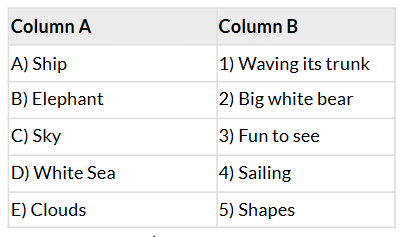A Show of Clouds - 1 Class 2 Worksheet English Mridang
Multiple Choice Questions
Q1: What animal does the speaker see looking down at them while lying on their back?
A) A lion
B) A big white bear
C) A rabbit
D) A bird
Q2: What does the speaker see sailing in the sky?
A) A plane
B) A ship
C) A cloud
D) A kite
Q3: What is the color of the sea mentioned in the poem?
A) Blue
B) Green
C) White
D) Black
Q4: Which animal is described as waving its trunk?
A) A giraffe
B) An elephant
C) A monkey
D) A tiger
Q5: How does the speaker feel about seeing shapes in the clouds?
A) Bored
B) Happy
C) Scared
D) Confused
Fill in the Blanks
Q1: As I lie on my back, I see a big white ______.
Q2: I see a ______ sailing on a white sea.
Q3: I see an elephant, waving its ______ at me.
Q4: It’s fun to see whatever I want to ______.
Q5: Looking up at the ______, brings joy to me.
True or False
Q1: The speaker sees a bear looking down at them.
Q2: The sea described in the poem is blue.
Q3: The poem mentions an airplane sailing in the sky.
Q4: The speaker enjoys seeing shapes in the clouds.
Q5: An elephant is mentioned as waving its tail.
Match the Following
You can access the solutions to this worksheet here.
|
1 videos|494 docs
|
FAQs on A Show of Clouds - 1 Class 2 Worksheet English Mridang
| 1. What are the different types of clouds mentioned in the article "A Show of Clouds"? |  |
| 2. How do clouds form according to the article? |  |
| 3. Why is it important to observe clouds? |  |
| 4. What activities can help us learn more about clouds? |  |
| 5. How do clouds affect our daily weather? |  |

















